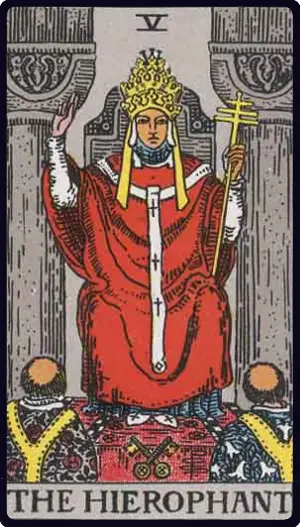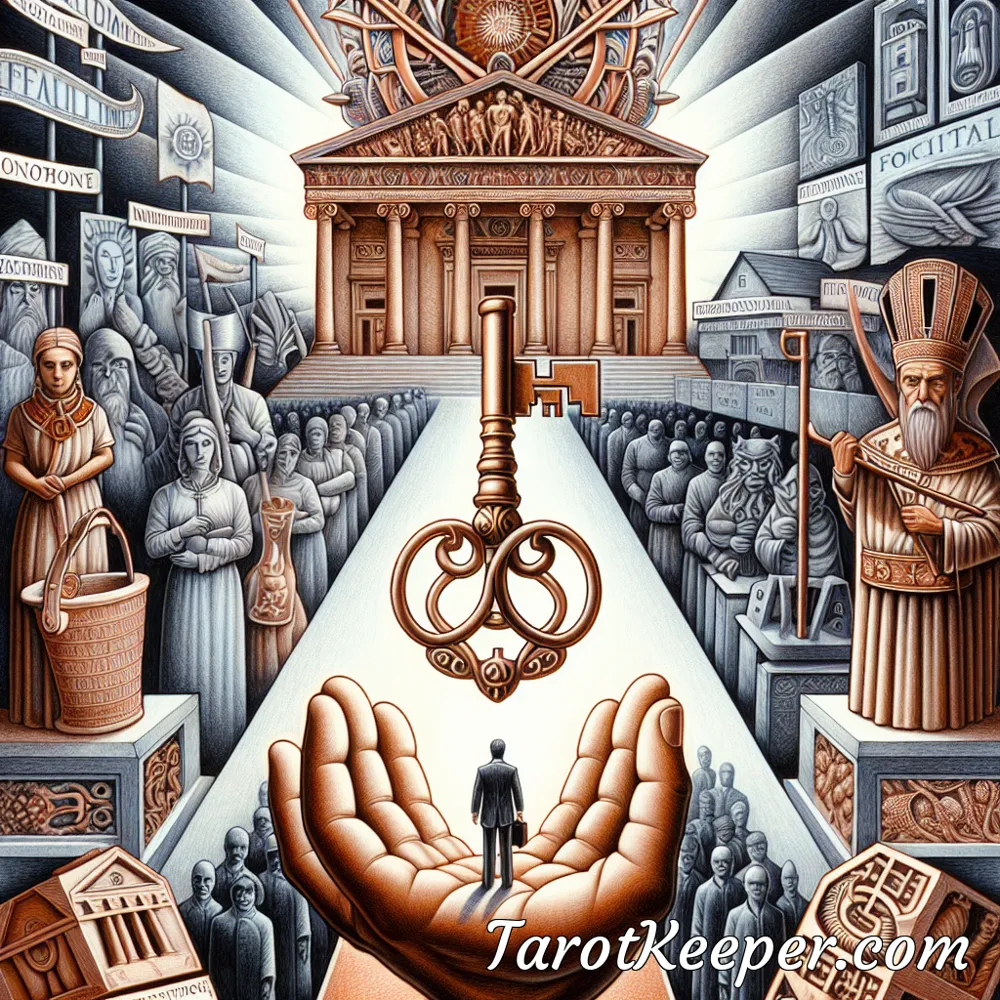


The Hierophant is a significant card in the tarot deck, representing tradition, conformity, and religious or spiritual guidance. When this card appears in a past position in a tarot reading, it suggests that the influence of tradition and authority has played a crucial role in shaping the querent's past experiences and decisions. In this article, we will delve into the interpretation of The Hierophant in the past position, exploring its significance and implications for the querent's journey.
Before delving into the specific implications of The Hierophant in the past position, it is essential to understand the core symbolism and meaning of this card. The Hierophant is often depicted as a religious or spiritual figure, adorned in ceremonial robes and seated between two pillars, symbolizing duality and balance. He represents the bridge between the spiritual and material worlds, offering guidance and wisdom based on established traditions and beliefs.
When The Hierophant appears in a tarot reading, it signals the importance of conformity to societal norms, adherence to traditional values, and seeking guidance from established institutions or authorities. This card encourages the querent to seek wisdom from spiritual or religious sources and to embrace the teachings of tradition.

When The Hierophant appears in the past position, it indicates that the querent's past experiences have been significantly shaped by traditional values, cultural norms, or institutionalized beliefs. The influence of religious or spiritual upbringing, adherence to societal expectations, and respect for authority figures may have played a pivotal role in shaping the querent's early experiences and decisions.
This placement suggests that the querent's past may have been characterized by a strong emphasis on tradition and conformity, with an inclination towards seeking guidance from established institutions or religious authorities. The influence of familial, cultural, or institutional traditions may have exerted a profound impact on the querent's early development and decision-making processes.
When The Hierophant appears in the past position, it also signifies the importance of conforming to social expectations and adhering to established norms. The querent's past experiences may have been marked by a strong sense of duty, obligation, and adherence to societal conventions. This influence may have led the querent to prioritize conformity and tradition in their past actions and choices.
Furthermore, The Hierophant in the past position suggests that the querent may have sought validation and guidance from authority figures or traditional institutions, allowing their decisions and actions to be shaped by external expectations and norms. This emphasis on conformity and adherence to established standards may have influenced the querent's early experiences and set the tone for their journey thus far.
In addition to the influence of tradition and conformity, The Hierophant in the past position highlights the significance of seeking spiritual or religious guidance in the querent's past. This placement suggests that the querent may have turned to established religious or spiritual traditions for wisdom, solace, and moral guidance during their formative years.
The emphasis on seeking spiritual or religious counsel from traditional sources indicates that the querent's past experiences may have been deeply intertwined with the teachings and practices of organized religion or spiritual institutions. The influence of these traditions and beliefs may have provided the querent with a framework for understanding the world and making sense of their experiences.
When The Hierophant appears in the past position, it invites the querent to reflect on the role of tradition, conformity, and spiritual guidance in shaping their early experiences and decisions. This placement encourages the querent to examine how the influence of tradition has impacted their past journey and contributed to the development of their beliefs and values.
Furthermore, The Hierophant in the past position prompts the querent to integrate the lessons and wisdom gained from traditional influences into their present understanding and decision-making processes. By acknowledging the significance of tradition and conformity in their past, the querent can gain insight into the foundations of their beliefs and values, allowing for greater self-awareness and personal growth.
While The Hierophant emphasizes the importance of tradition and conformity, it also encourages the querent to recognize their own authority and autonomy in shaping their path forward. When this card appears in the past position, it signals a pivotal moment for the querent to reclaim their personal power and sovereignty, transcending the limitations of external expectations and traditional influences.
By acknowledging the impact of tradition and conformity in their past, the querent can embark on a journey of self-discovery and empowerment, embracing their individuality and personal beliefs. The Hierophant in the past position serves as a catalyst for the querent to assert their own values and principles, integrating the wisdom of tradition while forging their unique path forward.
As the querent navigates the influence of The Hierophant in the past position, they are invited to embrace change and growth, transcending the confines of tradition and conformity. This placement signifies a transformative opportunity for the querent to break free from rigid structures and explore new perspectives, allowing for personal evolution and expansion.
By acknowledging the influence of tradition in their past and recognizing the impact of conformity on their journey, the querent can embrace change with a newfound sense of self-awareness and agency. The Hierophant in the past position serves as a catalyst for the querent to embrace their individuality, charting a course that honors their personal growth and authenticity.
In conclusion, The Hierophant in the past position carries profound implications for the querent's journey, highlighting the influence of tradition, conformity, and spiritual guidance on their past experiences and decisions. This placement invites the querent to reflect on the role of tradition in shaping their early development and to integrate the wisdom gained from traditional influences into their present understanding. By embracing personal authority and embracing change, the querent can navigate the transformative potential of The Hierophant, transcending the constraints of tradition and forging their unique path forward.
Have questions or need guidance? Reach out to us anytime at [email protected]
We're here to help you on your tarot journey.
© Copyright 2024 by TarotKeeper.com. All rights Reserved.